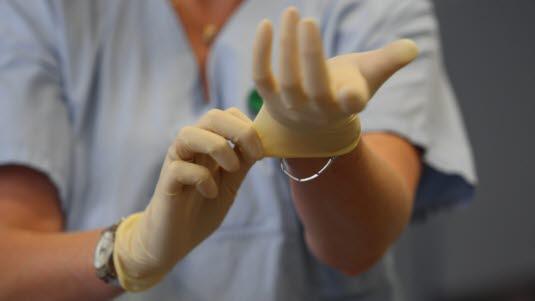Lateksallergi
Lateksallergi er først og fremst knyttet til bruk av gummihansker. Det fører til utvikling av håndeksem og i sjeldnere tilfeller til mer alvorlig allergi.

Sist oppdatert:
4. juli 2018
Bruk av latekshansker har vist seg å beskytte helsearbeidere effektivt mot mange infeksjonssykdommer. Men noen helsearbeidere kan få allergiske reaksjoner ved eksponering av lateks. Antallet rapporter om slike reaksjoner har økt de senere årene, både fordi latekshansker brukes mer enn før og fordi brukerne er mer klar over allergirisikoen. Forekomsten av lateksallergi i den generelle befolkningen er funnet å være 1-2 prosent.
Hva er lateks?
I denne artikkelen refererer betegnelsen "lateks" til naturgummi som er utvunnet fra gummitreet (Hevea brasiliensis). Det finnes flere typer syntetisk lateks, men disse avgir ikke de proteinene som medfører allergiske reaksjoner.
Vil du vite mer
Dette dokumentet er basert på det profesjonelle dokumentet Lateksallergi . Referanselisten for dette dokumentet vises nedenfor
- Pollart SM, Warniment C, Mori T. Latex allergy. Am Fam Physician 2009; 80: 1413-8. American Family Physician
- Hamilton RG. Latex allergy: Epidemiology, clinical manifestations, and diagnosis. UpToDate, last updated April 16, 2014. UpToDate
- Taylor JS, Erkek E. Latex allergy: diagnosis and management. Dermatol Ther 2004; 17: 289-301. PubMed
- Phaswana SM, Naidoo S. The prevalence of latex sensitisation and allergy and associated risk factors among healthcare workers using hypoallergenic latex gloves at King Edward VIII Hospital, KwaZulu-Natal South Africa: a cross-sectional study. BMJ Open 2013; 3:e002900.
- Pollart SM, Warniment C, Mori T. Latex allergy. Am Fam Physician 2009; 80: 1413-8. American Family Physician
- Larese Filon F, Bosco A, Fiorito A, Negro C, Barbina P. Latex symptoms and sensitisation in health care workers. Int Arch Occup Environ Health 2001; 74: 219-23. PubMed
- Bousquet J, Flahault A, Vandenplas O, et al. Natural rubber latex allergy among health care workers: a systematic review of the evidence. J Allergy Clin Immunol 2006; 118: 447-54. PubMed
- Nettis E, Assennato G, Ferrannini A, Tursi A. Type I allergy to natural rubber latex and type IV allergy to rubber chemicals in health care workers with glove-related skin symptoms. Clin Exp Allergy 2002; 32: 441-7. PubMed
- Sapan N, Nacarkucuk E, Canitez Y, Saglam H. Evaluation of the need for routine preoperative latex allergy tests in children. Pediatr Int 2002; 44: 157-62. PubMed
- Schmid K, Christoph Broding H, Niklas D, Drexler H. Latex sensitization in dental students using powder-free gloves low in latex protein: a cross-sectional study. Contact Dermatitis 2002; 47: 103-8. PubMed
- Suli C, Lorini M, Mistrello G, Tedeschi A. Diagnosis of latex hypersensitivity: comparison of different methods. Eur Ann Allergy Clin Immunol 2006; 38: 24-30. PubMed
- Hamilton RG. Latex allergy: Management. UpToDate, last updated April 21, 2014. UpToDate
- Smith AM, Amin HS, Biagini RE, et al. Percutaneous reactivity to natural rubber latex proteins persists in health-care workers following avoidance of natural rubber latex. Clin Exp Allergy 2007; 37: 1349-56. PubMed
- Degenhardt P, Golla S, Wahn F, Niggemann B. Latex allergy in pediatric surgery is dependent on repeated operations in the first year of life. J Pediatr Surg 2001; 36: 1535-9. PubMed
- Ausili E, Tabacco F, Focarelli B, Nucera E, Patriarca G, Rendeli C. Prevalence of latex allergy in spina bifida: genetic and environmental risk factors. Eur Rev Med Pharmacol Sci 2007; 11: 149-53. PubMed
- LaMontagne AD, Radi S, Elder DS, Abramson MJ, Sim M. Primary prevention of latex related sensitisation and occupational asthma: a systematic review. Occup Environ Med 2006; 63: 359-64. PubMed
- Nettis E, Colanardi MC, Soccio AL, et al. Double-blind, placebo-controlled study of sublingual immunotherapy in patients with latex-induced urticaria: a 12-month study. Br J Dermatol 2007; 156: 674-81. PubMed
- Nucera E, Schiavino D, Sabato V, et al. Sublingual immunotherapy for latex allergy: tolerability and safety profile of rush build-up phase. Curr Med Res Opin 2008; 24: 1147-54. PubMed
- Bernardini R, Pecora S, Milani M, Burastero SE. Natural rubber latex allergy in children: clinical and immunological effects of 3-years sublingual immunotherapy. Eur Ann Allergy Clin Immunol 2008; 40: 142-7. PubMed